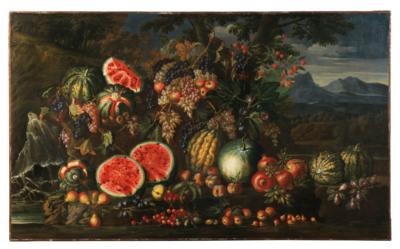Roman School, 17th Century

Watermelons, grapes, cherries, figs, pomegranates and other fruit, a landscape beyond,
oil on canvas, 147.5 x 248.5 cm, framed
The present composition shows a variety of fruit depicted with great realism with contrasts of chiaroscuro. Each single item appears carefully studied in order to attain perspectival depth.
From the end of the sixteenth century onwards, still-life painting in Italy acquired an increasingly autonomous role: flowers, fruits, vegetables and birds were no longer subordinate and used only as decorative elements in painted festoons and vines, but obtained a role of their own and were represented as the main subject. Rome became the centre for this kind of production in Italy, as during this period there was an increasing interest in nature (see D. Simone, Aspetti della natura morta romana, in: A. Bacchi/F. Mambelli/E. Sambo [eds.], La natura morta di Federico Zeri, Bologna 2015, p. 271).
The present painting can be compared to other examples of Roman still-life painting from the first half of the seventeenth century deriving from the influence of Caravaggio, among them works by Giovanni Paolo Castelli, called Spadino (circa 1586–1659), and the so-called Monogrammist F. A. (see G. Bocchi, Monogrammista FA, in: Pittori di natura morta a Roma. Artisti italiani 1630–1750, Viadana (Mantova) 2005, pp. 491-498).
Expert: Mark MacDonnell
 Mark MacDonnell
Mark MacDonnell
+43 1 515 60 403
old.masters@dorotheum.com
11.05.2022 - 16:00
- Dosažená cena: **
-
EUR 57.600,-
- Odhadní cena:
-
EUR 30.000,- do EUR 40.000,-
Roman School, 17th Century
Watermelons, grapes, cherries, figs, pomegranates and other fruit, a landscape beyond,
oil on canvas, 147.5 x 248.5 cm, framed
The present composition shows a variety of fruit depicted with great realism with contrasts of chiaroscuro. Each single item appears carefully studied in order to attain perspectival depth.
From the end of the sixteenth century onwards, still-life painting in Italy acquired an increasingly autonomous role: flowers, fruits, vegetables and birds were no longer subordinate and used only as decorative elements in painted festoons and vines, but obtained a role of their own and were represented as the main subject. Rome became the centre for this kind of production in Italy, as during this period there was an increasing interest in nature (see D. Simone, Aspetti della natura morta romana, in: A. Bacchi/F. Mambelli/E. Sambo [eds.], La natura morta di Federico Zeri, Bologna 2015, p. 271).
The present painting can be compared to other examples of Roman still-life painting from the first half of the seventeenth century deriving from the influence of Caravaggio, among them works by Giovanni Paolo Castelli, called Spadino (circa 1586–1659), and the so-called Monogrammist F. A. (see G. Bocchi, Monogrammista FA, in: Pittori di natura morta a Roma. Artisti italiani 1630–1750, Viadana (Mantova) 2005, pp. 491-498).
Expert: Mark MacDonnell
 Mark MacDonnell
Mark MacDonnell
+43 1 515 60 403
old.masters@dorotheum.com
|
Horká linka kupujících
Po-Pá: 10.00 - 17.00
old.masters@dorotheum.at +43 1 515 60 403 |
| Aukce: | Obrazy starých mistrů I |
| Typ aukce: | Sálová aukce s Live bidding |
| Datum: | 11.05.2022 - 16:00 |
| Místo konání aukce: | Wien | Palais Dorotheum |
| Prohlídka: | 30.04. - 11.05.2022 |
** Kupní cena vč. poplatku kupujícího a DPH
Není již možné podávat příkazy ke koupi přes internet. Aukce se právě připravuje resp. byla již uskutečněna.
